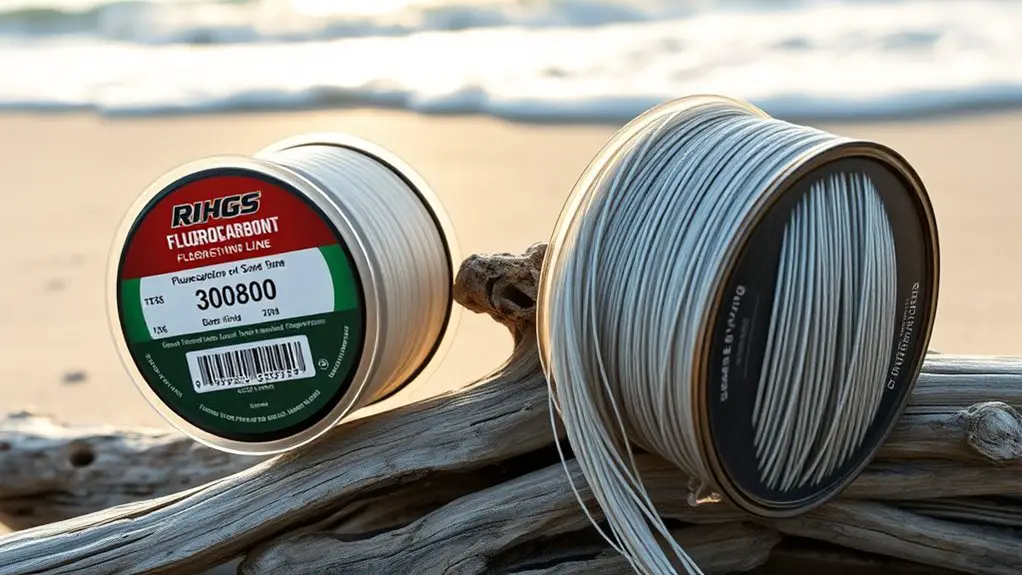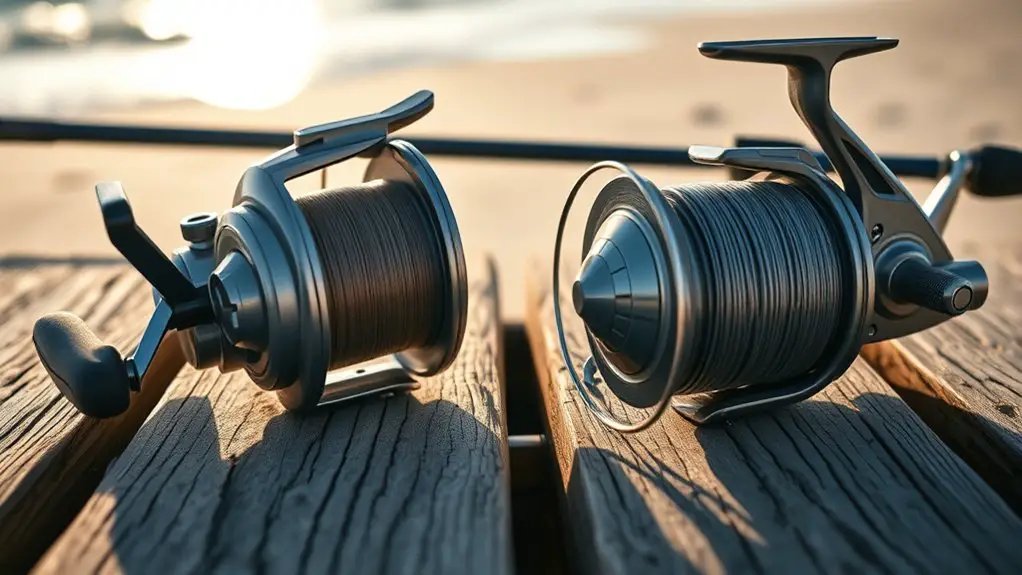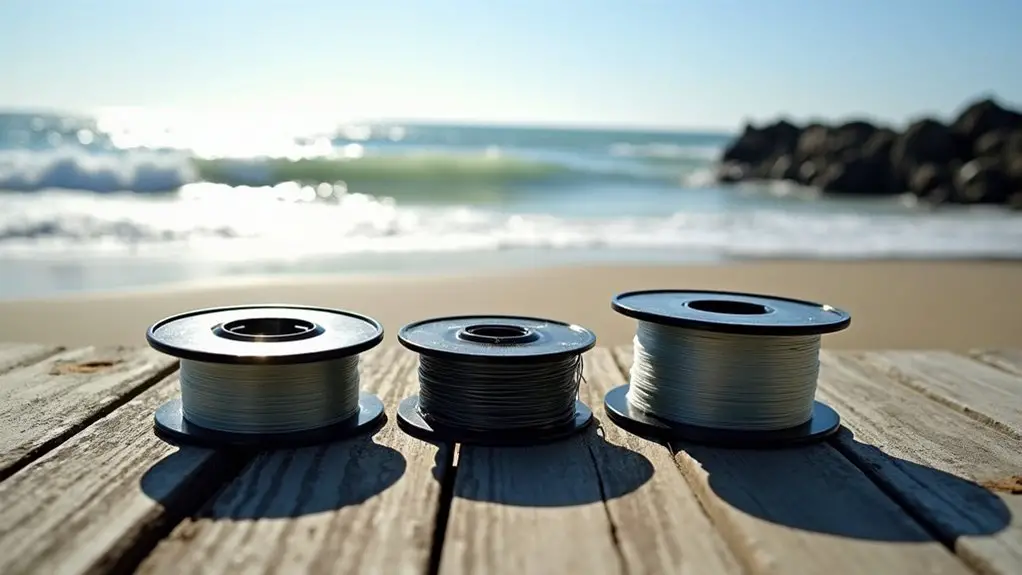For surfcasting, your line choice depends on conditions and target species. Most anglers find 10-15 lb braided line works well for versatile beach fishing, while rough surf calls for 17-20 lb test. Follow the 10:1 rule—your line strength should be ten times your sinker weight (1 oz sinker = 10 lb test). Braided lines offer better casting distance with thinner diameters, while mono provides more stretch for fighting fish. The perfect setup balances your specific beach terrain with the monsters you’re hoping to hook.
Surf Fishing Highlights
- 10-15 lb braided line is versatile for most surfcasting situations, offering good casting distance and adequate strength.
- Apply the 10:1 rule: line strength should equal ten times your sinker weight (1 oz sinker = 10 lb line).
- Heavy surf conditions require 17-20 lb line for better control and durability against rough waters.
- Consider 30-50 lb test (medium) line for a balanced performance ideal for bass and stripers.
- Braided lines provide better casting distance due to thinner diameter, while monofilament offers more shock absorption.
Understanding the Basics of Surfcasting Line Selection
When you’re setting up your surfcasting gear, choosing the right line size can make or break your fishing success. The perfect line balances casting distance with enough strength to handle your target species and surrounding conditions.
For most situations, 10-15 lb braided line offers versatility that’ll serve you well on the beach.
Remember, thinner diameter means longer casts and better bite detection, but you’ll sacrifice some durability around rocks and reefs. Your environment matters too—heavy surf demands heavier line (17-20 lb) to maintain control, while calm conditions let you downsize for stealth. Consider using a moderate-action rod![]() when fishing with heavier lines, as it provides better shock absorption when fighting larger fish. Ten-foot rods
when fishing with heavier lines, as it provides better shock absorption when fighting larger fish. Ten-foot rods![]() are the most popular length for surfcasting as they provide excellent casting distance while maintaining good maneuverability in various fishing environments.
are the most popular length for surfcasting as they provide excellent casting distance while maintaining good maneuverability in various fishing environments.
Don’t forget to match your line to your rod’s action!
If you experience frequent backlashes while casting into the wind, it’s a strong indication that your line size is too small![]() and you should consider upgrading to a thicker diameter.
and you should consider upgrading to a thicker diameter.
The 10:1 Rule: Line Strength to Sinker Weight Ratio
One essential guideline that’ll transform your surfcasting success is the 10:1 rule—a simple formula that takes the guesswork out of matching line to sinker. This rule recommends your line’s breaking strength should be approximately ten times your sinker’s weight. Selecting appropriate pyramid sinkers![]() will help maintain stability in varying surf conditions. Using braid main line
will help maintain stability in varying surf conditions. Using braid main line![]() in appropriate strengths provides optimal casting performance while maintaining sensitivity for detecting bites.
in appropriate strengths provides optimal casting performance while maintaining sensitivity for detecting bites.
| Sinker Weight | Recommended Line Strength | Best For |
|---|---|---|
| 1 oz | 10 lb test | Calm conditions |
| 2 oz | 20 lb test | Light surf |
| 4 oz | 40 lb test | Moderate current |
| 6 oz | 60 lb test | Heavy surf |
You’ll avoid frustrating breakoffs during powerful casts while still maintaining ideal distance. Remember, it’s better to slightly overestimate than underestimate—nothing ruins a day faster than watching your terminal tackle disappear into the waves!
Monofilament vs. Braided Lines for the Surf
Choosing between monofilament and braided line for surfcasting isn’t just about personal preference—it’s a tactical decision that directly impacts your fishing success.
In clear water, mono’s translucency gives you a stealth advantage that braid simply can’t match, even with leaders.
While braid’s impressive strength-to-diameter ratio lets you pack more muscle onto your reel, mono’s natural stretch acts as your insurance policy against those heart-stopping runs when a trophy fish bolts for the horizon. For topwater presentations in the surf zone, mono’s buoyancy benefits create a more natural floating bait action that can trigger more strikes. Beginners often find that mono is cheaper![]() and provides a more forgiving experience when learning to cast in challenging surf conditions.
and provides a more forgiving experience when learning to cast in challenging surf conditions.
Your local surf conditions should guide your choice—rocky bottoms might call for braid’s durability, while mono shines when knot reliability trumps raw power. Braid’s small diameter cuts through water resistance better, allowing for extended casting distance![]() that can help you reach fish beyond the breaking waves.
that can help you reach fish beyond the breaking waves.
When to Use Fluorocarbon in Your Surf Setup

While monofilament and braided lines each have their place in the surf, fluorocarbon introduces a whole new dimension to your surfcasting arsenal.
You’ll want to reach for fluoro when targeting line-shy species in clear water—its refractive index makes it nearly invisible underwater.
Consider fluorocarbon essential when fishing around structure. Its superior abrasion resistance handles rocks, reefs, and barnacles that would shred mono. When fishing challenging environments like rocky shores or reefs, AFTCO’s Saiko fluorocarbon offers increased durability post-abrasion![]() compared to standard fluorocarbon options.
compared to standard fluorocarbon options.
The material’s low stretch dramatically improves bite detection (you’ll feel those subtle nibbles!) and produces faster hooksets. The UV resistance![]() of fluorocarbon line means it maintains its strength and performance longer in sunny coastal environments compared to monofilament.
of fluorocarbon line means it maintains its strength and performance longer in sunny coastal environments compared to monofilament.
Don’t overlook fluoro’s sinking properties, which keep your presentation natural against surf currents and wave action.
Regular reties are necessary with fluorocarbon since its rigidity leads to weakened knots![]() under the strain of fighting large surf species.
under the strain of fighting large surf species.
Heavy Casting Leaders: Why They Matter
Heavy casting leaders serve as the critical buffer between your main line and terminal tackle, protecting your entire setup during those powerful surf casts.
You’ll want to follow the 10:1 rule—for every ounce of lead, use 10 pounds of leader strength (toss a 5-ounce sinker? That’s a 50-pound leader, folks!).
While monofilament leaders offer excellent stretch and knot-friendly handling, wire leaders shine when toothy critters like sharks cruise the surf. The leader length should be at least equal to your rod length![]() plus some extra to allow for proper casting mechanics. For longer beachcasters, consider using higher breaking strain
plus some extra to allow for proper casting mechanics. For longer beachcasters, consider using higher breaking strain![]() leaders to accommodate increased pressure during power casting. Using low-stretch mono leaders
leaders to accommodate increased pressure during power casting. Using low-stretch mono leaders![]() helps maintain maximum energy transfer during high-energy casts rather than wasting power through excessive stretching.
helps maintain maximum energy transfer during high-energy casts rather than wasting power through excessive stretching.
Mono provides the flex you need, but only wire stands up to those jagged shark teeth lurking in the waves.
Remember to inspect and replace frayed leaders regularly; it’s much cheaper than losing that trophy fish (and your favorite lure) to preventable breakage!
Line Requirements for Different Target Species
Now that we’ve covered your leader needs, let’s size up the main line for your target species. Your quarry’s size dictates everything about your line choice—from diameter to breaking strength.
| Species Type | Line Test (lb) | Diameter (inch) | Characteristics | Best For |
|---|---|---|---|---|
| Light | 10-20 | 0.008-0.013 | High sensitivity | Trout, panfish |
| Medium | 30-50 | 0.014-0.018 | Balanced performance | Bass, stripers |
| Heavy | 60-80 | 0.018-0.022 | Abrasion resistant | Sharks, large catfish |
| Trophy | 100-250 | 0.022-0.035 | Maximum strength | Deep-sea giants |
| All-Around | 30 | ~0.015 | Versatile compromise | Mixed fishing |
You’ll want medium lines for most surfcasting scenarios—they’re the sweet spot between casting distance and strength. Going too light? You’ll snap off during the cast. Too heavy? Kiss your casting distance goodbye! The minimal stretch![]() of braided lines gives you superior hook-setting power when you’re battling waves and currents from the shoreline. Many experienced surf anglers prefer 30# mono
of braided lines gives you superior hook-setting power when you’re battling waves and currents from the shoreline. Many experienced surf anglers prefer 30# mono![]() directly to their leader for its superior durability and abrasion resistance when fishing in rough surf conditions. For best results, consider selecting a reel that can hold at least 250 yards of 30lb braid
directly to their leader for its superior durability and abrasion resistance when fishing in rough surf conditions. For best results, consider selecting a reel that can hold at least 250 yards of 30lb braid![]() , which provides ample line capacity for fighting larger fish that might make long runs during the fight.
, which provides ample line capacity for fighting larger fish that might make long runs during the fight.
Matching Line Size to Your Rod and Reel Ratings

Selecting the proper line size isn’t just about what you’re catching—it’s equally essential to match your line to your rod and reel specifications.
Your rod’s power rating directly dictates suitable line weights: light rods (6-10 lb test), medium rods (10-20 lb test), and heavy rods (20-30+ lb test).
Don’t ignore that balance between components! A 12-foot surf rod typically works beautifully with 15 lb test, while your reel must have adequate capacity for your chosen line diameter. For medium beach fishing outfits targeting species like whiting and bream, a 15 lb line![]() with 200-250m capacity is typically recommended.
with 200-250m capacity is typically recommended.
Remember, using line outside the rod’s recommended range is asking for trouble—either snapped lines or compromised casting distance.
The sweet spot? When rod, reel, and line work as a synchronized team. For maximum effectiveness, consider rods with fast action![]() characteristics when using lighter lines that require more sensitivity for detecting subtle bites.
characteristics when using lighter lines that require more sensitivity for detecting subtle bites.
How Beach Conditions Affect Your Line Choice
When you step onto the beach, powerful forces of nature are already dictating your ideal line choice before you even make your first cast. Heavy surf demands thicker, abrasion-resistant lines (15-30 lb test), while gentle waves allow lighter options for better casting distance.
Your battleground’s composition matters too—rocky bottoms call for braided lines with protective coatings, while sandy beaches forgive lighter setups.
Strong currents? Beef up your line to prevent frustrating line drag and maintain bait position.
Don’t forget the wind factor! Thinner diameter braids slice through coastal breezes, giving you distance when Mother Nature’s trying to push back.
Signs It’s Time to Replace Your Surfcasting Line
Even the highest quality surfcasting line won’t last forever, as the harsh coastal environment constantly works to break down your fishing tackle.
Coastal elements wage war on your line—quality can resist, but never truly defeat, the sea’s persistent assault.
Watch for visible red flags: fraying fibers, nicks, discoloration, or unusual stiffness. Your line’s crying for retirement!
Performance issues are equally telling. If you’re experiencing shorter casts, failing knots, or mysterious mid-fight breaks, don’t blame bad luck—blame old line.
Monofilament and fluorocarbon typically need replacement every 6-12 months, while braided lines last longer but aren’t immortal.
Specialty Lines for Extreme Surf Conditions

Three critical factors separate ordinary surfcasting from battling extreme surf conditions: your equipment must be tougher, more specialized, and perfectly matched to the environment.
When facing monster waves and powerful currents, braided lines shine with their remarkable strength-to-diameter ratio (20 lb braid has roughly the same diameter as 6 lb mono—talk about punch in a small package!).
Pair your braid with hefty 50-100 lb mono leaders spanning 40-50 inches to absorb shock and resist abrasion.
Don’t forget those spider sinkers or storm weights; they’ll anchor your rig while others watch their baits tumble helplessly to shore.
Balancing Casting Distance With Line Strength
The ultimate surfcasting dilemma faces every angler who steps onto the beach: finding that sweet spot between maximum casting distance and sufficient line strength.
You’re caught between wanting to reach those distant fish and having enough muscle to land them when they bite!
Your perfect balance depends on four key factors:
- Target species size (bigger fish = stronger line)
- Surf conditions (rougher water demands heavier test)
- Structure presence (rocks and reefs require abrasion resistance)
- Rod/reel specifications (match your gear’s recommended ratings)
Frequently Asked Questions
Can I Use the Same Line for Night Surfcasting as Daytime?
Yes, you can use the same line for both day and night surfcasting, but consider making some adjustments.
While your standard mono or braid will work around the clock, you’ll benefit from adding a high-visibility section or bright-colored leader at night to track your line better.
Daytime fishing might call for more stealth with clear leaders, but your main line can remain consistent.
Just remember to inspect it regularly—nighttime snags are sneakier than their daylight cousins!
How Does Water Temperature Affect Line Performance When Surfcasting?
You’d think water temperature wouldn’t matter much for your line, but it’s surprisingly impactful!
In cold water, your line becomes stiffer with more memory and tangles, while warm water makes it more supple and manageable. Cold water’s higher viscosity increases drag, potentially reducing your casting distance.
You’ll also notice changes in line abrasion resistance and stretch properties as temperatures shift.
Consider adjusting your drag settings in colder conditions, as fish behavior becomes less predictable with temperature fluctuations.
Should Line Size Change When Fishing Different Tide Cycles?
Yes, you should absolutely adjust your line size during different tide cycles.
During strong incoming tides, opt for heavier (20-30 lb) line that can withstand increased drag and debris.
When tides slack off, you can downsize to 12-15 lb test for better casting distance and sensitivity.
Remember, those rushing flood tides aren’t just bringing in fish—they’re bringing in line-shredding challenges!
Your perfect setup at dawn might be all wrong by midday as the tide changes.
Is Line Color Important for Surfcasting Success?
Line color can make a difference that’s as stark as night and day in surfcasting success.
In clear water, you’ll want low-visibility options like clear, green, or blue to avoid spooking fish. For murky conditions, high-vis colors (yellow or fluorescent green) help you track line movement without alarming your targets.
Match your color to water clarity and depth—what works in the flats won’t necessarily work in deep surf.
How Do Wind Knots Affect Surfcasting Line Strength?
Wind knots greatly reduce your line’s strength by up to 50%, creating weak points where your line crosses itself.
They’re like tiny ticking time bombs in your setup! Each knot forms a stress concentration area that’s prone to breakage, especially when you’re battling that trophy fish.
You’ll want to regularly inspect your line and remove these pesky tangles.
Different line materials react differently too—braided lines are particularly vulnerable due to their thinner diameter and lower stretch capacity.
Conclusion
You’ve now navigated the nuanced necessities of surfcasting success! Remember, your line selection isn’t just about strength—it’s about sensible setup for specific situations. Whether you’re battling breakers with braided line or feeling for fish with fluorocarbon, you’ll catch more consistently when you’ve matched your line to conditions. The perfect pound-test provides both power and precision. Trust your tackle, test your techniques, and you’ll transform from casual caster to competent surfside angler!

